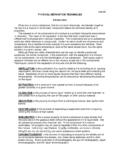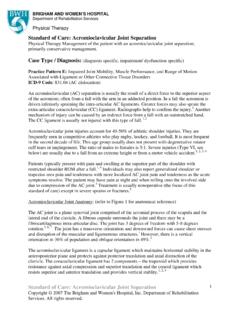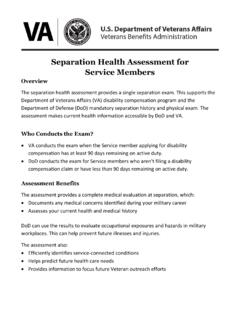Transcription of Combined Sewer Overflow Management Fact Sheet: Sewer ...
1 United States Office of Water EPA 832-F-99-041. Environmental Protection Washington, September 1999. Agency Combined Sewer Overflow Management Fact Sheet Sewer separation DESCRIPTION Many communities have studied and evaluated CSO. control strategies that would effectively reduce, if Sewer systems that convey both sanitary sewage not necessarily eliminate, CSOs and their associated and storm water through a single pipe are referred health and ecological risks. One of the strategies to as Combined Sewer systems (CSSs). In dry often considered is Sewer separation . weather and during light to moderate rainfall, the CSS is able to convey all flows to the wastewater Sewer separation is the practice of separating the treatment facility.
2 During periods of heavy rainfall, Combined , single pipe system into separate sewers however, the capacity of the CSS may be exceeded, for sanitary and storm water flows. In a separate often causing untreated Combined sewage and storm system, storm water is conveyed to a storm water water to back up into basements and to Overflow outfall for discharge directly into the receiving from manholes onto surface streets. Traditionally, water. Based on a comprehensive review of a CSS outfalls were designed to discharge directly community's Sewer system, separating part or all of into receiving waters during Combined Sewer its Combined systems into distinct storm and sanitary overflows (CSOs).
3 This was done to prevent the Sewer systems may be feasible. Communities that excessive Combined flows from directly impacting elect for partial separation typically use other CSO. public health via basement and street flooding. controls in the areas that are not separated. In addition to flooding problems, CSOs can cause APPLICABILITY. problems in receiving water bodies. CSOs can contain untreated domestic, industrial, and Sewer separation can be considered wherever there commercial wastes, as well as storm water runoff. is a CSS. However, an evaluation of the most Contaminants contributed by these sources include appropriate CSO control should be performed prior potentially high concentrations of suspended solids, to selecting Sewer separation or any other measure.
4 Biochemical oxygen demand (BOD), oils and grease, Sewer separation has often been the appropriate toxics, nutrients, floatables, pathogenic technology in areas where one or more of the microorganisms, and other pollutants. CSO following conditions exist: pollution has caused many receiving waters to exceed water quality standards, resulting in threats Most sewers are already separated;. to public health, aquatic species, or aquatic habitat. CSO pollutants have impaired receiving water body Siting constraints and costs prohibit the use uses and have contributed to restrictions on shellfish of other structural measures;. harvesting, occasional fish kills, and numerous beach closures.
5 Potential odors and solids deposits The uses and the assimilative capacities of in the receiving water body can also compromise receiving waters prohibit the use of other aesthetics and limit recreational uses of the water CSO controls;. body. Other CSO strategies are not publicly work ( , road repaving and the repair or acceptable; replacement of miscellaneous utilities, such as water and cable lines) could be conducted more cost Additional infrastructure improvements, effectively if it were to coincide with Sewer such as road repaving, are also required; separation . For example, as a result of the CSO. program in the City of St. Paul, MN, streets were The Combined system is undersized; paved and handicap ramps were added to sidewalks, gas and water mains were installed, gas services Elimination of CSOs is desired; and/or were renewed or replaced, lead water service connections were replaced, and street lights were Other CSO measures are not able to achieve installed.
6 The community's goals. Separating CSSs may contribute to improvements to Sewer separation has been used effectively in many water quality due to the reduction or elimination of communities. Most of the approximately 1,000 sanitary discharges to receiving water bodies. communities that are served by CSSs are located in However, the increased storm water discharges the Northeast and the Great Lakes region. resulting from Sewer separation could decrease the Complete or partial separation of CSSs has positive impacts of the separation unless storm occurred in many of these areas, as well as in several water discharges are mitigated. Without mitigation, locations in the West.
7 Cities that have completely increased loads of storm water pollutants, including or partially separated CSSs include: Minneapolis, heavy metals, sediments, and nutrients, may run off St. Paul, and South St. Paul, MN; the metro into local water bodies. For example, in Atlanta, Detroit, MI, area; the metro Boston, MA, area; GA, Sewer separation was predicted to increase Salem and Portland, OR; the metro Seattle, WA, pollution to local creeks (AMSA, 1994) as polluted area; Lynchburg, VA; Bangor, ME; Hartford and storm water previously reaching the treatment plants Norwich, CT; and Remington, IN. Columbus, OH, now is discharged directly into receiving waters. has recently elected to separate its CSS as well.
8 However, in many cases, separating sewers reduces pollution to receiving waters, as described above for One of the largest Sewer separation projects St. Paul, MN. A second example of successfully occurred in Minneapolis, St. Paul, and South St. reducing pollution to receiving water bodies has Paul, MN. The project involved pipe separation in occurred in Juneau, AK. It has been reported that more than 21,000 acres of drainage area. By in Juneau, where there is in excess of 70 inches of December 1996, 189 miles of storm sewers and precipitation a year, the storm water concentrations miles of sanitary sewers had been installed. conveyed through the recently separated storm This program was needed to reduce the number of water sewers are rather dilute.
9 This has also been overflows that were estimated to occur an average attributed to large quantities of clean groundwater of once every three days (American City and that infiltrate into the storm Sewer , relatively clean County, 1996). Overflows have been significantly activities within the watershed, and several reduced by this separation project. non-point source pollution control programs within the City (City of Juneau, 1997). Existing and future ADVANTAGES AND DISADVANTAGES storm water impacts to the receiving water body should be evaluated prior to implementing Sewer Positive impacts resulting from Sewer separation separation . include: reduction or elimination of basement and street flooding; reduction or elimination of sanitary Negative impacts associated with Sewer separation discharges to receiving waters; decreased impacts to include extensive construction and construction aquatic species and habitat; decreased contact risk related impacts ( , noise, dust, erosion), with pathogens and bacteria from domestic sewage disruption to residents and businesses, possible in the receiving water; and relief from CSO disruptions in Sewer service, and the need for storm regulations.
10 In addition, incidental infrastructure water controls or best Management practices. In addition, complete separation of sanitary and basements, reducing street flooding, and storm water flows can be hard to accomplish reconstructing aging portions of the Sewer system whether the Combined Sewer is converted to a storm (MWCC, 1984). Sewer or to a sanitary Sewer . Complete separation of a CSS would involve disconnection of all storm Sewer separation can be accomplished through water drainage structures, sump pumps, and roof installing new storm or sanitary sewers to be used in and footer drains. Disconnection of footer drains is conjunction with the existing Sewer . Economics, often not cost effective.













